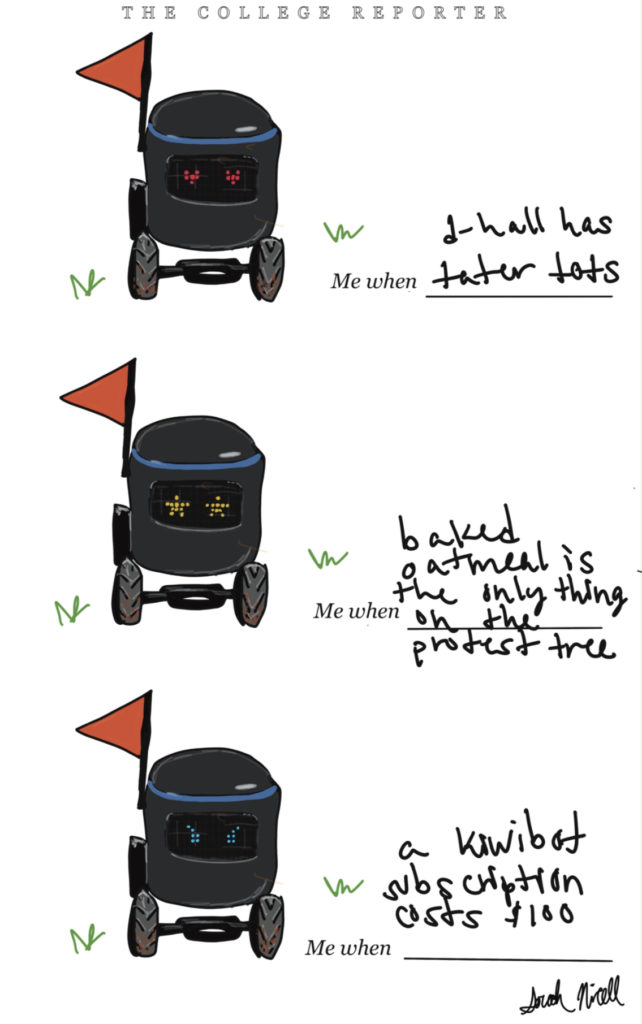By Lily Vining | Campus Life Editor

Students returning to campus this fall would likely have noticed the cute, Wall-E-esque robots stationed outside the dining facilities. These 12 bots, produced by the 2017 Columbian start-up Kiwibots, collect dining orders from various locations around campus and deliver them to students. In partnership with Sodexo, F&M’s dining service, the company has deployed 500+ robots on 26 college campuses across the United States, in addition to using them in cities throughout the Americas.
After attending a conference on Kiwibots in March 2021, Drew Niemann, Dining Service General Manager, and Mike Baker, AVP of Auxiliary Services, sought to introduce the new technology to F&M by first running a pilot to an incoming class. Erik Kessler, Operations Manager of Dining, says that the decision was intended “to be a service enhancement and innovative function on behalf of the institution.” He also notes that the college does not currently make any profit from the delivery bots, and even had to spend money in order to get the program running.
The delivery process begins when one places an order through the Everyday App and receives status updates on the order. When food is ready, the robot is then dispatched to the destination. Using a mixture of computer vision and GPS to track its location, it drives on sidewalks and crosswalks, avoiding pedestrians in its path. It can drive up to 2 miles per hour, slightly slower than the average adult walking at a speed of 3-4 miles per hour, which could cause some backup on footpaths, especially during passing periods. After it arrives, the customer should press a button on their app to open the lid and retrieve their food. The process is estimated to take 20-35 minutes depending on the food preparation time, distance, and peak hours.
The delivery process is relatively simple, perfect for students deep in a study session who do not want to leave to grab a meal. In exchange for convenience, the service requires either a subscription— starting from $40 to $179 per semester— or a one-time $2.00 delivery fee, plus a service fee of 10% of the total order. While students can use a meal swipe for the food itself, the delivery fee is an additional charge. Orders are open to students anywhere on campus. At the present, the bots are not making deliveries to off-campus residences.
While the technology is new on F&M’s campus, most students are familiar with some form of food delivery service. Many students, especially those living on campus without a car, rely on apps like UberEats and DoorDash to satisfy their restaurant fix when they cannot, or do not want to, leave their dorms. While the cost of the Kiwibots appears steep on its surface, it is in line with the price charged for popular delivery apps. A one-time delivery from the bot is $2.00 plus a service charge of 10% of the meal — charged by a third-party app, not covered by a meal plan — which is in line with other delivery services. DoorDash’s service fee for a single order was 11 percent, and Grubhub’s was 5 percent. The price of some meal deliveries, especially after accounting for restaurant markups, delivery charges, and service fees, can be upwards of 25-91% higher than what one pays in the restaurant, one NYTimes journalist discovered. When deciding where to spend their money on food delivery, students should think twice about how much they pay out of pocket for either on-campus or outside services.
The robots also deliver more than just food, they inspire feel-good emotions— or at least, this was the company’s aim during their recent rebranding campaign. Alejandro Otálora, Director of Design at Kiwibot, said that “This is the first time that we are evolving not only in terms of our brand, but also with new ideas to communicate through the robot’s eyes, sounds, and movements.” The bots’ quirky emotions, shown through their screens, are an attempt to connect with the target audience of young adults. Otalora expresses his hope to “conquer your heart and steal your breath while we deliver what you need, miss, crave, and love” — however, the jury is still out on whether these strong emotions can be evoked by a DHall meal.
Photo Courtesy of kiwibots.com
Junior Lily Vining is Campus Life Editor and Investigative Reporter. Her email is lvining@fandm.edu.